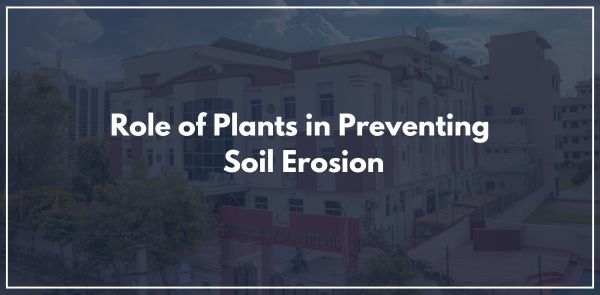
The soil is a mixture of inorganic minerals and organic matter that covers the uppermost layer of the Earth's land surface (Lithosphere). The denudation, degradation, or loss of topsoil leading to disorganization, transportation, or removal by various factors is referred to as soil erosion. Plants are intimately related to the soil due to the root system that is deeply embedded into the soil. The loss of protective vegetation makes soil vulnerable to being swept away by wind and water.
Poddar International College, with its commitment to academic excellence and practical learning, serves as a launch pad for aspiring leaders.
In addition, over-cultivation and compaction cause the soil to lose its structure and cohesion and it becomes more easily eroded. Erosion will remove the top-soil first. Once this nutrient-rich layer of soil is gone, few plants will grow in the soil again. Without soil and plants the land becomes desert-like and unable to support life. Students of Poddar International College, participate in many competitions related to soil erosion
The plant grows as it feeds from the nutrients available in the soil, after the plant dies it actually replenishes the soil. The new seed grows into a new root and the same cycle starts again, and the soil continues to get better.
Poddar International College's industry collaborations and Internships provide students with real-world experiences, enhancing their employability in various sectors.
As for the other side of the story, the plant dies and nourishes the soil, but the erosion washes away the nutrient rich soil. The exposed rock mud or sand fails to support the next generation of the plant. In other words, the next plant does not grow which leads for the sun to superheat the soil so it breaks and cracks. Next, the cracked soil accelerates erosion which means that no further plant life can grow in this erosion. The erosion continues to expand, eating the edges of surrounding plant life.
Plants provide protective cover on the land and prevent soil erosion for the following reasons:
There are several plants that are effective in helping to prevent soil erosion due to their root systems that help bind the soil together. Some of the best plants for controlling soil erosion include:
Grasses: Grasses are commonly used for erosion control due to their fibrous root systems that help hold the soil in place. Some examples include fescue, ryegrass, and Bermuda grass.
Groundcovers: Low-growing plants like creeping juniper, vinca, or pachysandra can help prevent erosion by spreading over the soil surface and reducing water runoff.
Shrubs: Shrubs with dense root systems can help stabilize soil on slopes. Plants like forsythia, butterfly bush, and juniper are good choices for erosion control.
At Poddar International College – one of the top Colleges in Rajasthan the pedagogy is complemented by innovative approaches that encourage critical thinking and creativity.
Trees: Trees with spreading root systems can help prevent soil erosion on hillsides. Species like willow, poplar, and pine can be effective in stabilizing slopes.
Legumes: Leguminous plants like clover and alfalfa not only help prevent erosion but also improve soil fertility by fixing nitrogen.
When selecting plants for erosion control, it's important to consider the specific conditions of the site, such as soil type, slope, sunlight exposure, and climate. Native plants are often a good choice because they are well-adapted to the local environment and are more likely to thrive.
With its unwavering commitment to excellence, Poddar International College, emerging as the best college in Jaipur which continues to shape the future of education and inspire generations to come.